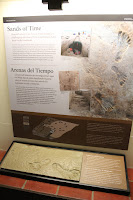The wild rock formations that gave the Organ Mountains their name hid under a blanket of clouds. The San Augustin Mountains didn’t fare much better. The mild rise to San Augustin Pass barely feels like a mountain gap.
In winter, the Tularosa Basin hid its treasure well. The gypsum dunes of White Sands National Park barely register near the road. Some scraggly, plant-covered dunes lie just past the White Sands Missile Range.
A national monument from 1933 until 2019, White Sands' entrance had the same look as in 2016 on my only previous visit. The historic district comprised of Pueblo revival buildings housing the visitor center and adjacent stores stood in contrast to the sharp white dunes. But this visit was a world away. With a living dune field, it can’t help but change. Plus, White Sands yielded an unprecedented archaeological find in recent years.
 |
| White Sands map |
I would consider any trip to White Sands magical. My last visit came on a sunny September day, the heat blazing and the sands blinding. The light was bruising and I resolved never to go without sunglasses again that day. Even on a cloudy day not getting into the 40s, the dunes required sunglasses. As exquisite as they look, the gypsum sand dunes thoroughly resemble snow mounds, and can prove unkind to the eyes.
Everything is scenic once the dunes surround you. They roll for miles in every direction. Mountain ranges rim every horizon. The rain fell sporadically, but never hard enough to chase us off the dunes. White Sands owes its existence to past lakes and seas.
The Tularosa Basin once sat below the shallow sea that reached over to the Permian Basin in west Texas. Gypsums crystals from that sea rose to the tops of nearby mountains. As the winds eroded them, the crystals settled on the basin. As the waters evaporated, the crystals broke down into sand.
In wetter climate times, the Tularosa Basin was mostly covered by Lake Otero, a 1,600-square-mile lake (white sands covers 275 square miles, still the world’s largest gypsum dune field).Lake Otero flourished at the end of the last Ice Age helped to show evidence of a healthy ecosystem, with mammoths, predators, and more, including early humans. Sixty preserved footprints found at the site have dated between 21,000 and 23,000 years ago. Some have disputed the dates, but the prints correspond to seeds of that age found in the same sedimentary layer.
In the 21st century, White Sands still sees plenty of action from water. Lake Lucero, a remnant of Lake Otero, reappears in the park during rainy times in the park’s southeastern corner.
Unlike the stable dune field at the Great Sand Dunes, which has worked its way to the northwest corner of Colorado’s San Luis Valley, White Sands move all the time in the Tularosa Basin. They leave plants that grew on their slopes, but the yuccas have adapted with deep-running roots.
In some places, the yucca almost turn into forests, the plant’s underground structures make them look larger than they typically would. The yucca will die as the dunes move on. Skunkbush does better, with roots that form sand pedestals that become denning sites for kit foxes.Aside from the occasional car on the park road, the dunes grew incredibly silent. Even with determined hikers marching into the fields only to turn back after the January wind caught them, voices didn’t carry. The screams of joy did, mostly from children sledding a few hills away. The light rain solidified the dunes and made for a better experience, although none of the dunes close to the road were tall enough for a long ride.
Most of all, I relished wandering the dunes. Everything became wilderness beyond sight of the road. You could lose your path easily as new dunes without vegetation all tend to look identical. Spitting rain, Southwest winter conditions – it couldn’t have been a better time to get lost among the sands of the Tularosa Basin.
I don’t know in what season I will next grace the gypsum dunes, but I will have to roam and get a little more lost. Besides, the whole place will have changed again.






No comments:
Post a Comment